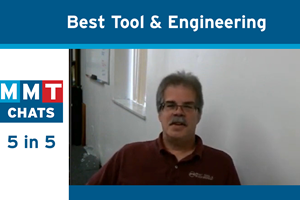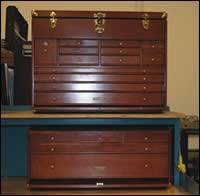Part One of a Two-Part Series Optimizing Mold Performance And Maintenance Efficiency
The first three steps of a six-step process for strategizing for improvement in shop operations when it comes to how we maintain molds.
Mold performance and maintenance efficiency are two completely different yet entirely connected goals of the modern day mold repair shop. Mold performance has been an issue ever since the first part hung up in cavity, with maintenance efficiency—or the approach used when we repair molds—taking a back seat in terms of significance to the overall aspect of producing plastic parts.
So in other words, the idea of maintenance efficiency has always been more connected to making sure that a mold is production ready rather than the manner this is accomplished, or how it got that way.
Judging Efficiency
We can only utilize the tools (people, machines, hand tools, space and money) given us by our company. If a mold shop supervisor has more molds sitting red-tagged (needing work) than get pulled on a weekly basis (MPP) then is his shop efficient? Probably not. Will anybody notice? Probably not. So why is maintenance efficiency important if the molds are ready when needed? Because as Captain Kirk used to say, “It’s the final frontier”.
Everything in plastics manufacturing gets scrutinized in this day. From the inception of the part, to the mold design, then the build and finally production. But maintenance is normally left wide open, and to the devices of craftsmen behind the bench.
The rule has simply been to do what it takes to get a mold in the press and keep it running. If this is accomplished, everything else is forgiven. But in today’s market companies are beginning to look closely at how these mold performance goals are met. Budget factors—such as excess tooling usage, unscheduled mold stops due to maintenance related issues, excessive labor hours along with the usual array of flashed manifolds, damaged tooling, water leaks and non-conforming product—are no longer being considered as “just part of the process” that competing manufacturing companies must deal with.
Budget Breakdown
With an eye on increasing shrinking profit margins, mold maintenance is now coming under close scrutiny from the mold owners (customer) and proprietary bean-counters chair—that is, common shop issues that we deal with every day are having costs associated with them so that they can be measured by the people footing the mold repair bills.
So be prepared, it’s a new day in a new era. No longer can companies be focused solely on meeting orders, that should be a given. To excel in the game, we must raise the maintenance bar. We must concern ourselves with how we maintain molds. Are we systemized in our approach or are we doing the same thing the same old way over and over expecting different results? Someone famous once said that was the definition of insanity, but in too many mold shops it’s the definition of reality.
To have a better understanding of how mold performance and maintenance efficiency are diametrically connected to increas-ing profitability, let’s break them down.
Mold Performance
- Improve production reliability
- Increase cavity efficiency
- Maximize mold/tooling life
- Decrease cycle time
- Improved part quality
- Reduce scrap rates
Maintenance Efficiency
- Optimize mold repair hours
- Reduce tooling usage
- Improve mold knowledge and defect awareness for better troubleshooting
- Standardize repairs/methods and procedures for consistency
- Reduce maintenance mistakes
- Faster training for new employees
- Improve shift-to-shift communication
Three Typical Objectives to Overcome
As with every goal or desire to improve a process there are usually challenges or barriers that stand in our way. When putting an unhealthy maintenance shop under the microscope the cell structure is seldom consistent from plant to plant, making the exact treatment less obvious, but the anemic shop is normally stricken by one of these three viruses.
- Time Limitations
- MPP or Mold Pull Pace (pulling molds faster than you can get them production ready or green-tagged) usually the result of shop downsizing, “no hire” practices, acquiring new molds, rash of breakdowns, etc.
- Toolroom supervisor tasked with other responsibilities besides mold management, typically new mold builds or plant equipment issues
- Repair techs tasked with other responsibilities, such as ancillary and plant equipment maintenance
- Corner Office Culture
- Not maintenance-oriented
- No clear reporting structure concerning mold repair
- Employee resistance (tooling and process; salary and hourly)
- Do not want to give up the freedom and monetary benefits that comes with:
- Freelancing repairs (do what I want)
- Time commitment (when I want)
- No accountability (not my problem; not my fault)
- Being “the shop king” (knows the most about all the molds)
- Hero cookies (the firefighter of the day)
So How Do You Begin?
Regardless of the above barriers, we must begin to strategize for improvement. There is no silver bullet and we must be careful not to start out making rash decisions based on perceived issues or unproven facts and innuendo. Remember that you are dealing with seasoned skilled tradesmen who don’t favor being “jerked around” on an assumption of overnight success. Many fitness programs have been attempted in maintenance and fail because the repair techs know that all that is necessary is to “weather it out” and things will soon return to normal—normal being zero expectations and zero accountability.
First you must choose the parameters that you want to improve, then establish a baseline of measurable data to use as a barometer. For this article we will discuss the first three steps of a six-step process:
- Clean-up and Organize Your Shop
It is hard for anyone to believe that anything will be improved in a repair shop that looks like a pig-pen. Clean up shelves, benches, floors and empty chip trays and put tools away.
Tag and organize tooling that has been removed from molds. Once the shop is cleaned, take an hour every Monday morning and keep it that way. - Stop the Bleeding
First, let everyone know (meetings, board posts, e-mail, grapevine) that monitoring of mold stop reasons is taking place and will be measured for change on a monthly basis. Simply publicizing the fact that the issues will be monitored and posted will immediately help reduce the personnel-related stop reasons attributed to inattention or carelessness. Accountability begins now. - Access the Damage
Keep it simple. Utilize your CMMS (computerized maintenance management system) reports or manually count occurrences to find out where you are (see Chart 1 below).
1. Categorize your Unscheduled Mold
Stop Events by:
- Stop Reason Description
- Frequency
- Corrective Action Costs (By Labor, By Tooling and Total)
Let production know you are monitoring their issues also, and to please let the toolroom know (via IML Sheets, e-mail, W/Os etc.) if there is anything the toolroom can do to help or correct a reoccurring mold stop issue—such as parts or runners sticking, gas burns, non-fills/shorts, finish or problems requiring extreme process changes/tweaking.
Eliminating mental mistakes combined with targeting the most frequently occur-ring stop reasons for reduction, you will begin to see a decline in unscheduled downtime. A decrease in the unscheduled mold stop frequency count accomplishes several things quickly:
- Allows more time for you to concentrate on pro-active maintenance
- Provides measurable data in which to demonstrate improvement to the non-believers
- Reduces operational costs (labor, press downtime)
- Improves ability to meet production quotas and schedules
- Improves relations between tooling and process (this alone is worth the price of admission)
Drilling Down
After compiling the list of unscheduled mold stop reasons (one to six months depending upon your MPP), post them in the toolroom and send an e-mail to process and other concerned teammates concerning your targets. Many of these will be easily corrected by simply focusing on them. The challenge now becomes to agree upon an action plan and assign responsibility as required to eliminate or reduce the frequency of targeted stop reasons.
| Chart 1: Six-Month Study: X-Unscheduled Mold Stop Reason | |||||
| Mold Stop Reason |
Stop Count | Labor Hours | Labor Cost | Tooling Cost | Total Cost |
| X-Mold Damage |
17 | 271.75 | $13,587.50 | $27,968.26 | $41,555.76 |
| X-Low Mold Cavitation |
9 | 196.50 | $9,825.00 | $13,553.00 | $23,378.00 |
| X-Part Flash Issues |
14 | 130.50 | $6,475.00 | $6,496.25 | $12,971.25 |
| X-Electrical Issues |
5 | 45.50 | $2,275.00 | $9,765.00 | $12,040.00 |
| X-Heater Only Issues |
4 | 74.50 | $3,725.00 | $1,010.00 | $4,735.00 |
| X-Incorrect Mold Assembly |
3 | 6.50 | $325.00 | $3,750.00 | $4,075.00 |
| X-Parts Sticking |
7 | 54.80 | $2,740.00 | $900.00 | $3,640.00 |
| X-Internal Water Leak |
6 | 57.25 | $2,862.50 | $0.00 | $2,862.50 |
| X-Ejector Plate Won’t Function |
4 | 45.00 | $2,250.00 | $496.00 | $2,746.00 |
| X-Flashed Manifold |
4 | 53.75 | $2,687.50 | $0.00 | $2,687.50 |
| X-Part Functional Issues |
3 | 45.50 | $2,275.00 | $0.00 | $2,275.00 |
| X-External Oil Leak |
4 | 37.00 | $1,850.00 | $0.00 | $1,850.00 |
| X-Broken Gate Issues |
3 | 36.50 | $1,825.00 | $0.00 | $1,825.00 |
| X-Metal in Gate |
4 | 20.00 | $1,000.00 | $0.00 | $1,000.00 |
| X-Scuffed Tooling |
1 | 14.00 | $700.00 | $0.00 | $700.00 |
| X-Nonfill Issues |
2 | 12.50 | $625.00 | $0.00 | $625.00 |
| X-Part Dimensional Issues |
3 | 11.00 | $550.00 | $0.00 | $550.00 |
| X-Galled Tooling |
1 | 10.50 | $525.00 | $0.00 | $525.00 |
| X-Residue Leaching Out |
1 | 5.50 | $275.00 | $0.00 | $275.00 |
| X-Warped Parts |
1 | 5.00 | $250.00 | $0.00 | $250.00 |
| X-Flashed Mold |
1 | $0.00 | $250.00 | $0.00 | $250.00 |
| 97 | 1133.55 | $56,877.50 | $63,938.51 | $120,816.01 | |
| This chart shows that we stopped production for 21 different reasons. Mold Damage (red font) was our #1 issue based on total money spent on corrective actions. This will be our target focus requiring a full investigation of the 17 occurrences (Stop Count) broken down by mold, description, mold configuration, tooling damaged, shift stopped, personnel, press number, etc. We also will target (and publicize) the shop issues (blue font) as these are simply mental mistakes, and, as a show of good faith to process that the toolroom is serious about improving. Chart courtesy of MoldTrax. | |||||
Related Content
Hands-on Workshop Teaches Mold Maintenance Process
Intensive workshop teaches the process of mold maintenance to help put an end to the firefighting culture of many toolrooms.
Read MoreMaking Quick and Easy Kaizen Work for Your Shop
Within each person is unlimited creative potential to improve shop operations.
Read MoreICYMI: MMT Chats: True Leadership Leads to Mentoring, Part 1
This trio from TK Mold and Engineering in Romeo, Michigan, joins me to discuss the role of leadership and culture in mentorship. This episode is brought to you by ISCAR with New Ideas for Machining Intelligently.
Read MoreMMT Chats: 5 in 5 with Best Tool and Engineering
MoldMaking Technology Editorial Director Christina Fuges reveals 5 best practices for improving efficiencies within shops...in 5 minutes. Our guest is Joe Cherluck, President of Best Tool and Engineering in Clinton Township, Michigan. This episode is brought to you by ISCAR.
Read MoreRead Next
A Tribute to Tools and Those Who Use Them
Tools and the boxes that contain them tell a lot about the moldmaker and his/her talents.
Read MorePart Two of a Two-Part Series Optimizing Mold Performance And Maintenance Efficiency
The last three steps of a six-step process for strategizing for improvement in shop operations when it comes to how we maintain molds.
Read MoreHow to Use Continuing Education to Remain Competitive in Moldmaking
Continued training helps moldmakers make tooling decisions and properly use the latest cutting tool to efficiently machine high-quality molds.
Read More








.jpg;maxWidth=300;quality=90)



















